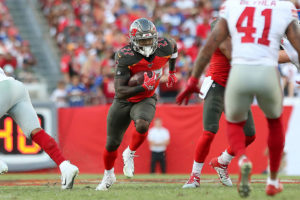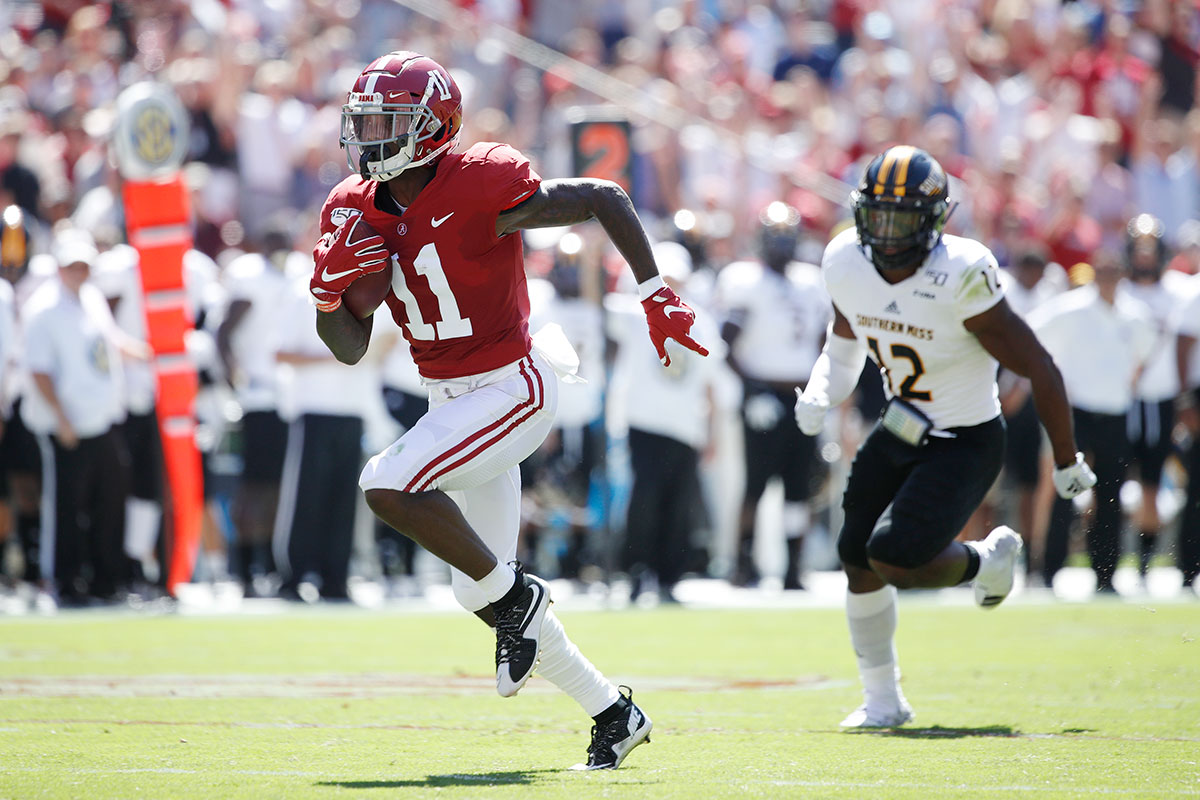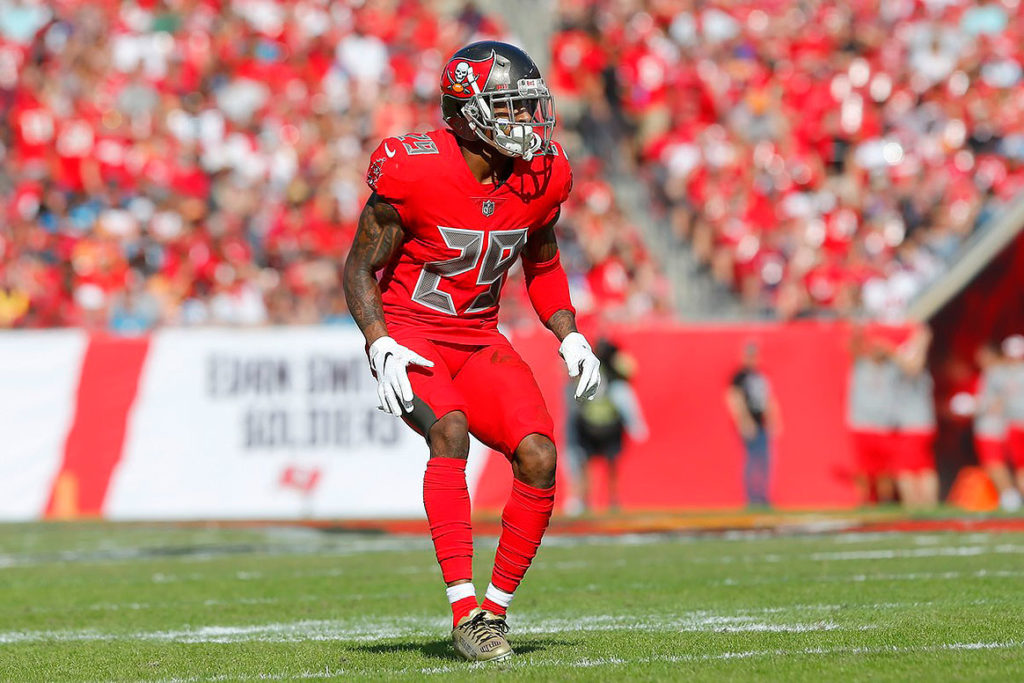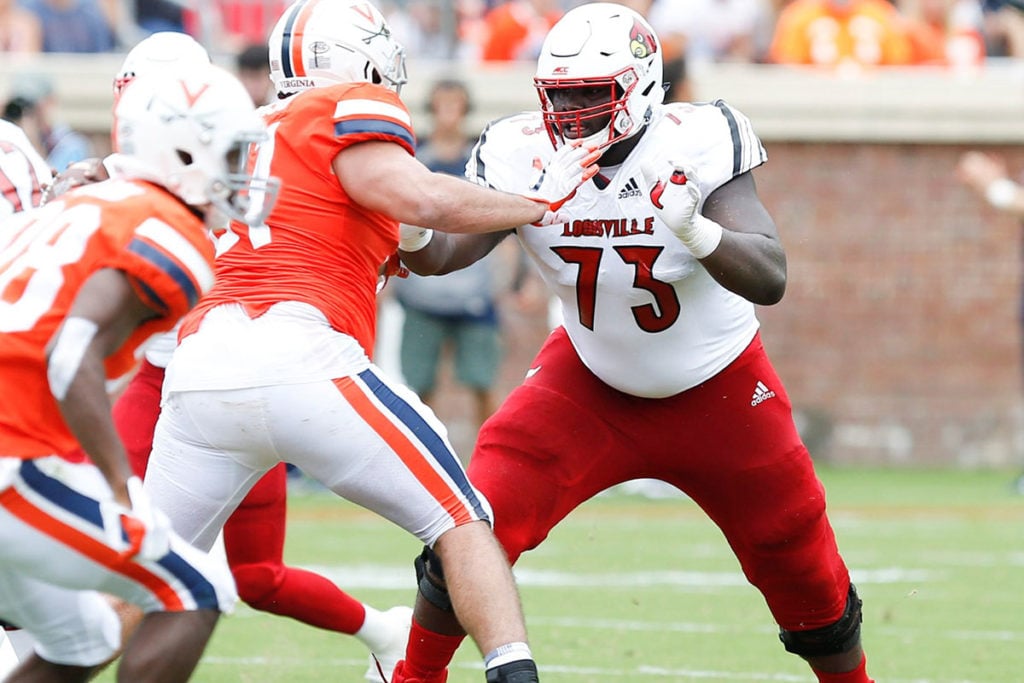FAB 3. Bucs Look To Draft A Pass-Catching RB
Head coach Bruce Arians made it clear on a conference call with Bucs beat writers this week that the team likes Ronald Jones II as a runner, but Tampa Bay needs to find some running backs that can be weapons in the passing game.
“We’d like to add a pass-catching back,” Arians said. “Our backs did a very good job in the screen game last year, especially RoJo – I thought he really excelled for the first time in the screen game. And, Dare [Ogunbowale] was pretty solid. But just using backs out of the backfield as wide receivers, as primary receivers – that’s not RoJo’s deal. Hopefully we can find somebody like that who can compete with Dare on third downs and become more of a wide receiver threat.”

Bucs RB Ronald Jones II – Photo by: Cliff Welch/PR
While there are some running back options available in free agency that can catch the ball, including Devonta Freeman, Chris Thompson and Carlos Hyde, the Bucs aren’t expected to use precious salary cap space on veterans. Instead, Tampa Bay will draft a running back – perhaps two – this year to replace Peyton Barber, who moved on to Washington in free agency, and compete with Ogunbowale, who was the team’s third-down back last year.
The good news for Arians and general manager Jason Licht is that the 2020 NFL Draft is loaded at running back with most of the premier rushers also possessing good receiving ability. New quarterback Tom Brady is a big fan of checking the ball down to his backs, and players like James White, Dion Lewis, Rex Burkhead, Shane Vereen, Brandon Bolden, Danny Woodhead and Kevin Faulk have caught an awful lot of passes from him over the years in New England.
Let’s take a look at some of the top multi-purpose backs in this year’s draft class and rank them in order of being the best fit for Brady in Tampa Bay.
1. LSU RB Clyde Edwards-Helaire – 5-7, 207 – Junior – 4.6
Edwards-Helaire is more quick and shifty than fast, but the Bucs, who had a formal interview with him at the NFL Scouting Combine, believe he’s a tick faster than his 4.6 time in the 40-yard dash. Edwards-Helaire emerged as LSU’s leading rusher during his junior campaign and wound up leading the SEC in rushing. But it was his career-high 55 catches for 453 yards that really makes him attractive to Tampa Bay.
Edwards-Helaire has a running style that is reminiscent of Darren Sproles and even former Buccaneer Doug Martin in his prime. He constantly keeps his legs churning, and has great contact balance. Edwards-Helaire picks up extra yardage from breaking tackles and eluding defenders with some wicked juke moves. As a receiver, no one works the sidelines better on swing routes out of the backfield.
Edwards-Helaire is a Day 2 pick and will likely be selected in the second round.
Edwards-Helaire’s LSU Career Rushing Stats
2017: 9 rushes for 31 yards (3.4 avg.)
2018: 146 carries for 658 yards (4.5 avg.), 7 TDs
2019: 215 carries for 1,414 yards (6.6 avg.), 16 TDs
Edwards-Helaire’s LSU Career Receiving Stats
2017: 3 catches for 46 yards (15.3 avg.)
2018: 11 catches for 96 yards (8.7 avg.)
2019: 55 catches for 453 yards (8.2 avg.), 1 TD
2. Georgia RB D’Andre Swift – 5-8, 212 – Junior – 4.48
Swift played behind Nick Chubb and Sony Michel as a freshman, and then shared carries with Elijah Holyfield before becoming the Bulldogs’ feature back last year. Swift is only one of five Georgia running backs to have multiple 1,000-yard rushing seasons, joining Herschel Walker (three), Chubb (three), Michel (two) and Knowshon Moreno (two) in that select company.
Swift, whom the Bucs had a formal interview with at the NFL Scouting Combine, possesses an amazing jump cut to make defenders miss, and has instant acceleration through the hole. Blessed with electric feet, he can reverse field with his great vision in an instant, and does a really good job of following his blockers, showing a great understanding of Georgia’s blocking schemes. Swift runs without hesitation, and has good power for his size. Like Edwards-Helaire, he played against some top SEC defenses and is a really creative runner. Swift has good stiff-arm, great hands and a tremendous feel for the passing game where he caught 73 career passes and averaged nine yards per catch while scoring five touchdowns.
Some consider Swift the best running back in the 2020 NFL Draft, and he will be an early second-round pick if a team doesn’t select him in the latter part of the first round.
Swift’s Georgia Career Rushing Stats
2017 81 carries for 618 yards (7.6 avg.), 3 TDs
2018 163 carries for 1,049 yards (6.4 avg.), 10 TDs
2019 196 carries for 1,218 yards (6.2 avg.), 7 TDs
Swift’s Georgia Career Receiving Stats
2017 17 rec. for 153 yards (9.0 avg.), 1 TD
2018 32 rec. for 297 yards (9.3 avg.), 3 TDs
2019 24 rec. for 216 yards (9.0 avg.), 1 TD
3. Memphis RB-WR Antonio Gibson – 6-0, 228 – Senior – 4.39
Gibson was in a logjam at Memphis, playing sparingly behind 1,000-yard rushers in Darrell Henderson, Tony Pollard and Patrick Taylor, Jr. He was a wide receiver and kick return specialist before being used as a combo running back-receiver in 2019 after Henderson and Pollard departed and Taylor got hurt. Gibson is the most experienced running back in the passing game as he caught passes out of the backfield, but also lined up out wide and in the slot.
Gibson had a formal interview with Tampa Bay at the NFL Scouting Combine and has the size and receiving ability that David Johnson, a former Arians back in Arizona, possesses. Aside from his versatility on offense, what makes Gibson attractive is his blazing 4.39 speed and ability to help the Bucs in the return game. He is electric with the ball in his hands, reads his blockers well and doesn’t get caught from behind. Gibson is exactly the kind of versatile receiving weapon Arians is looking for.
Due to his lack of opportunity and statistics at Memphis, Gibson figures to be an early Day 3 selection and should get draft in the fourth or fifth round.
Gibson’s Memphis Career Rushing Yards
2019 33 carries for 368 yards (11.2 avg.), 4 TDs
Gibson’s Memphis Career Receiving Yards
2018 6 receptions for 99 yards (16.5 avg.), 2 TDs
2019 38 receptions for 735 yards (19.3 avg.), 8 TDs
4. Ohio State RB J.K. Dobbins – 5-9, 209 – Junior – 4.50 (est.)
Dobbins was a workhorse at Ohio State where he rushed for at least 1,000 yards in three consecutive seasons. He capped off his junior year with 2,003 rushing yards and 21 touchdowns as one of the nation’s premier runners. Rarely getting caught from behind, Dobbins had the ability to make defenders miss or run them over with surprising power generated from his well-built lower body.
What makes Dobbins intriguing to the Bucs is that he is a complete, three-down back in the mold of Swift and Edwards-Helaire. He was a consistent receiver for the Buckeyes, and averaged 24 receptions per year, averaging over 10 yards per catch in each of his last two seasons at Ohio State. Dobbins doesn’t waste time with the ball in his hands and runs to daylight on screen passes. Dobbins gives maximum effort in pass protection, too.
Dobbins will be a Day 2 draft pick, likely being selected in the second round.
Dobbins’ Ohio State Career Rushing Stats
2017 194 carries for 1,403 yards (7.2 avg.), 7 TDs
2018 230 carries for 1,053 yards (4.6 avg.), 10 TDs
2019 301 carries for 2,003 yards (6.7 avg.), 21 TDs
Dobbins’ Ohio State Career Receiving Stats
2017 22 rec. for 135 yards (6.1 avg.), 1 TD
2018 26 rec. for 263 yards (10.1 avg.), 2 TDs
2019 23 rec. for 247 yards (10.7 avg.), 2 TDs
5. Florida State RB Cam Akers – 5-10, 217 – Senior – 4.47
Akers was incredibly productive at Florida State with two 1,000-yard rushing seasons in three years despite running behind a terrible offensive line. Akers is a workhorse back and amassed 27 touchdowns on the ground for the Seminoles, even taking some snaps as a Wildcat QB near the goal line. Akers is an urgent, decisive north-south runner with tremendous balance. He’s a great runner between the tackles and works the middle of the field well. There isn’t much hesitation to his game, and he picked up a lot of yards after deploying a wicked stiff arm.
Where Akers appeals to the Bucs is as a receiver where he showed a really good feel for the screen game and he lowers his shoulder and lowers the boom on defensive backs that try to tackle him. The Seminoles star showed he could line up at wide receiver and run routes, and has some similarities to former Arizona multi-purpose back David Johnson. Akers can even line up at quarterback and throw bubble screens, as well as throwing the ball downfield with accuracy on halfback passes.
Akers, who had a formal interview with the Bucs in Indianapolis, will likely be a Day 2 selection and should be drafted by the third round.
Akers’ Florida State Career Rushing Stats
2017 194 carries for 1,025 yards (5.3 avg.), 7 TDs
2018 161 carries for 706 yards (4.4 avg.), 6 TDs
2019 231 carries for 1,144 yards (5.0 avg.), 14 TDs
Akers’ Florida State Career Receiving Stats
2017 16 rec. for 116 yards (7.3 avg.), 1 TD
2018 23 rec. for 145 yards (6.3 avg.), 2 TDs
2019 30 rec. for 225 yards (7.5 avg.), 4 TDs
6. Wisconsin RB Jonathan Taylor – 5-10, 226 – Junior – 4.39
Taylor, who had an informal interview with Tampa Bay in Indianapolis, is the fastest running back in this year’s draft class, running a sub 4.4 time at 226 pounds. Taylor averaged over 2,000 yards per carry for all three seasons at Wisconsin, which is an incredible feat, and showed tremendous durability despite averaging over 300 carries per year. The Badgers legend is a great between-the-tackles runner who uses a blend of power and speed to slip defenders and find his way to the end zone, which he did 50 times on the ground in college.
Taylor wasn’t used much as a receiver in college in the run-first Badgers attack. Yet Wisconsin head coach Paul Chryst wanted to prepare Taylor for the NFL and incorporated him in the team’s passing game more often as a junior. Taylor responded by catching 21 passes for 252 yards (9.7 avg.) and scoring five touchdowns. While he dropped a few catchable balls, Taylor also made some tough, acrobatic hands, showing promise as a developing receiver out of the backfield. The good news for Taylor was that he didn’t drop a single pass during drills at the Combine.
Taylor is challenging Swift for the right to be the first running back taken in the 2020 NFL Draft, and will likely be a late first- or early second-round pick.
Taylor’s Wisconsin Career Rushing Stats
2017 299 carries for 1,977 yards (6.6 avg.), 13 TDs
2018 307 carries for 2194 yards (7.1 avg.), 16 TDs
2019 320 carries for 2,003 yards (6.3 avg.), 21 TDs
Taylor’s Wisconsin Career Receiving Stats
2017 8 rec. for 95 yards (11.9 avg.)
2018 8 rec. for 60 yards (7.5 avg.)
2019 21 rec. for 252 yards (9.7 avg.), 5 TDs
7. Memphis RB Patrick Taylor, Jr. – 6-1, 217 – Senior – 4.57
Despite having Henderson and Pollard in the backfield, Memphis coach Mike Norvell made sure to get the talented Taylor involved in the offense, too. While Taylor doesn’t have elite speed like Henderson, Pollard and Gibson possess, he can move for a bigger back, career average, which was over five yards per carry. Taylor was also used primarily around the goal line, and even played the Wildcat QB role where he used his great vision and tackle-breaking ability to amass 36 touchdowns on the ground.
Despite not being used as much as a receiver at Memphis, Taylor, who had an informal interview with the Bucs in Indianapolis, does have good hands as he had 55 career receptions for the Tigers and scored three times. Where he has tremendous value for the Bucs is as a pass protector, as he may be the most polished and effective back in protection in this year’s draft class. That is mightily important to Arians, who wants to make sure that the 42-year old Brady remains healthy for all 16 games in Tampa Bay this year.
Taylor will be a Day 3 draft pick, and would be a steal for the Bucs in the fifth round.
Taylor’s Memphis Career Rushing Stats
2016: 93 carries for 546 yards (5.9 avg.), 2 TDs
2017: 157 carries for 866 yards (5.5 avg.), 13 TDs
2018: 208 carries for 1,122 yards (5.4 avg.), 16 TDs
2019: 78 carries for 350 yards (4.5 avg.), 5 TDs
Taylor’s Memphis Career Receiving Stats
2016: 11 rec. for 37 yards (3.4 avg.)
2017: 19 rec. for 148 yards (7.8 avg.), 1 TD
2018: 17 rec. for 197 yards (11.6 avg.), 2 TDs
2019: 8 rec. for 52 yards (6.5 avg.), 0 TDs
8. Miami RB DeeJay Dallas – 5-10, 217 – Junior – 4.58
Dallas was a team captain and the heart and soul of Miami’s offense over the past two seasons, despite being underused. Dallas is a highly competitive runner with good balance and pop when colliding with defenders to get extra yardage. He was often used as a Wildcat QB as well as being a halfback and average close to six yards per carry for the Hurricanes with 17 touchdowns on the ground. Dallas is a very good athlete with a lot of upside as he heads to the NFL.
Dallas began his career as a wide receiver in high school before switching to running back as a freshman. He has very good hands, and it was surprising to see how seldom he was used as a pass-catcher out of the backfield. While he has work to do in pass protection from a technique standpoint, Dallas is a willing blocker and showed improvement as receiver throughout his Miami career.
The Bucs informally interviewed Dallas in Indianapolis, and he is likely a Day 3 pick due to his slower-than-expected 40-yard dash time, yet will be drafted no later than the fifth round.
Dallas’ Miami Career Rushing Stats
2017: 41 carries for 217 yards (5.3 avg.), 3 TDs
2018: 109 carries for 617 yards (5.7 avg.), 6 TDs
2019: 115 carries for 693 yards (6.0 avg.), 8 TDs
Dallas’ Miami Career Receiving Stats
2017: 4 catches for 92 yards (23 avg.)
2018: 10 catches for 85 yards (8.5 avg.)
2019: 14 catches for 140 yards (10 avg.), 2 TDs
Scott Reynolds is in his 30th year of covering the Tampa Bay Buccaneers as the vice president, publisher and senior Bucs beat writer for PewterReport.com. Author of the popular SR's Fab 5 column on Fridays, Reynolds oversees web development and forges marketing partnerships for PewterReport.com in addition to his editorial duties. A graduate of Kansas State University in 1995, Reynolds spent six years giving back to the community as the defensive coordinator/defensive line coach for his sons' Pop Warner team, the South Pasco Predators. Reynolds can be reached at: [email protected]




